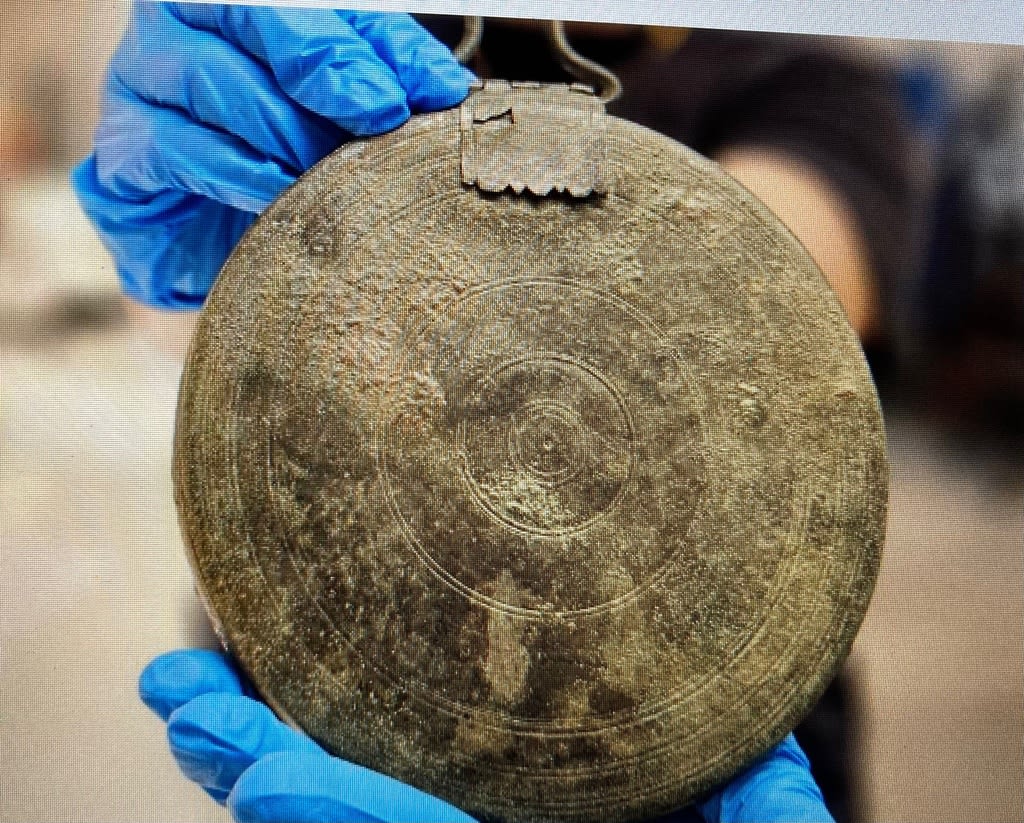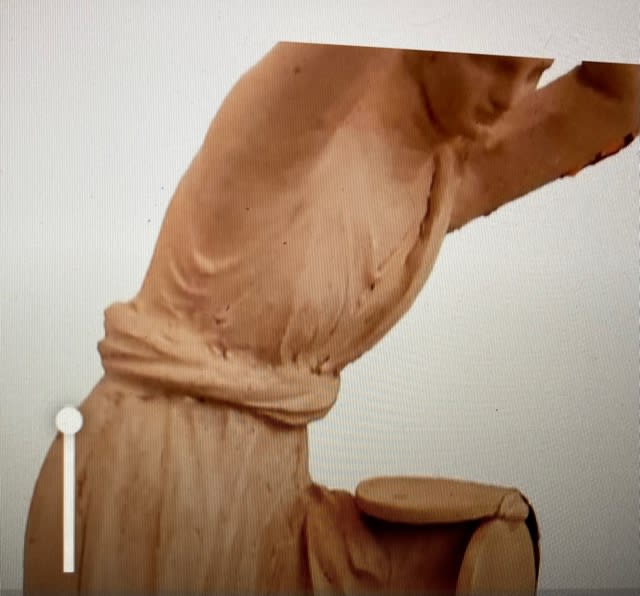
Mailで送られてくるLive Scienceの中の記事です。アレクサンドロス大王(
古代ギリシャのアルゲアス朝マケドニア王国のバシレウス(王)(在位:紀元前336年 - 紀元前323年)が遠征中にヘタイラ(高級遊女)を伴っていたことが、埋葬された女性の墓から見つかったブロンズミラーで発覚したという記事です。遠征(戦)に女性を伴っていたのですね。ブロンズの鏡の装飾品です。興味深いですね。琉球のジュリ(遊女)の位牌が祀られていた海蔵院(カガンヌウテラ)には鏡が祀られています。なぜか卑弥呼の銅鏡が思い出されます。
A 2,300-year-old grave in Israel contains the remains of a Greek courtesan who may have accompanied Alexander the Great's army!
サッシャ・パレイスラエルで2,300年前のブロンズミラーで埋葬された人間の遺体は、ヘレニズム軍のキャンペーンに同行した古代ギリシャの遊女(ヘタイラ)の最初の発見である可能性があります。
新しく発見されたブロンズミラーは、同心円のシンプルなパターンで装飾されています。(画像クレジット:ヨリ・シュワルツ、イスラエル考古局)
イスラエルで発見された道端の埋葬には、アレキサンダー大王の軍隊のキャンペーンに同行した古代ギリシャの遊女の火葬された遺体が保持されている可能性があります。
華やかなブロンズの鏡で埋葬された女性は、2,300年前にエルサレムへの道で、どの入植地からも遠く離れて休むために置かれ、彼女が軍人と一緒に旅行するプロの護衛、または「ヘタイラ」であった可能性があることを示唆しています—この種の最初の発見、考古学者はライブサイエンスと共有された声明で述べました。
「これは、ヘレニズム軍または政府の上級メンバーに同行したギリシャ出身の女性の墓である可能性が最も高い」と研究者たちは声明で述べた。彼女のクライアントは、アレキサンダー大王のキャンペーンの323つで戦ったか、紀元前<>年に亡くなった後、アレクサンダーの将軍が彼の後継者をめぐって戦ったディアドコイ戦争と呼ばれる一連の紛争で戦った可能性があると彼らは付け加えました。
彼女が亡くなったとき、女性は20歳から30歳だった、と研究者はイスラエルの新聞Haaretzに語った、そして彼女の遺体は彼女が「非常に貴重な」ブロンズ鏡と<>つの鉄の釘と一緒に埋葬される前に火葬されたことを示している。
関連する アレキサンダー大王には子供がいましたか?
鏡は、以前にグレコヘレニズムの埋葬で見つかったタイプの折りたたみボックスに囲まれており、女性のギリシャの起源を示唆しています。これらのアクセサリーは、理想化された女性や女神の姿の彫刻やレリーフを特徴とすることがよくありますが、新しく発見されたオブジェクトは、同心円のより単純なパターンで外側が装飾されています。
女性は持参金の一部としてブロンズの鏡も入手しましたが、当時の既婚女性はギリシャの家を離れることはめったになく、ましてや夫の軍事作戦に参加することは言うまでもないと研究者たちは付け加えました。
歴史的な記録は、アレキサンダー大王のキャンペーン中に遊女がいたことを示している、と研究者たちはハーレツに語った。彼らは性的サービスを提供しましたが、読み書きもでき、詩、ダンス、演技のパフォーマンスでクライアントを楽しませました。
「将軍や支配者に加わった人もいたことを私たちは知っています。有名なことに、ヘタイラのタイスは道路でアレクサンダーに加わり、彼は彼女が遠くにいるのが好きではありませんでした」と最近の発掘に参加したテルアビブ大学の考古学者であるガイ・スティーベルはハーレツに語った。
—中世の少女は、おそらく墓から「戻る」ことができなかったため、足首を縛られてうつ伏せに埋葬されました
—紀元前3世紀-女性は頭蓋骨に釘穴を開けて伏せて埋葬されました。その理由をご説明します。
—鉄器時代の戦士の女性は剣と鏡で埋葬されました
道端の墓で発見された鉄の釘は、邪眼を追い払い、故人が再び立ち上がるのを防ぐなど、「魔法の力」があると彼は付け加えた。釘は、古代ギリシャとローマの墓、および当時のユダヤ人の埋葬で頻繁に見られます。
研究者たちは、ブロンズミラーのより詳細な分析が、女性の背景と彼女が同行した男性についての手がかりを明らかにすることを望んでいます。
******
Saschaは、英国を拠点とするLive Scienceの研修生スタッフライターです。イギリスのサウサンプトン大学で生物学の学士号を、インペリアル・カレッジ・ロンドンで科学コミュニケーションの修士号を取得しています。彼女の作品は、ガーディアンと健康ウェブサイトゾーイに掲載されています。執筆の傍ら、テニス、パン作り、中古品店で隠れた宝石を探すことを楽しんでいます。
Human remains buried with a 2,300-year-old bronze mirror in Israel may be the first ever found of an ancient Greek courtesan who accompanied the Hellenistic armies on their campaigns.
The newly discovered bronze mirror is decorated with a simple pattern of concentric circles. (Image credit: Yoli Schwartz, Israel Antiquities Authority)
A roadside burial discovered in Israel may hold the cremated remains of an ancient Greek courtesan who accompanied Alexander the Great's armies on their campaigns.
The woman, who was buried with an ornate bronze mirror, was laid to rest 2,300 years ago on the road to Jerusalem and far from any settlement, suggesting she may have been a professional escort, or "hetaira," traveling with military men — the first discovery of its kind, archaeologists said in a statement shared with Live Science.
"It is most likely that this is the tomb of a woman of Greek origin who accompanied a senior member of the Hellenistic army or government," the researchers said in the statement. Her client may have fought in one of Alexander the Great's campaigns, they added, or in a series of conflicts called the Wars of the Diadochi, which saw Alexander's generals battle to succeed him after he died in 323 B.C.
The woman was 20 to 30 years old when she died, researchers told the Israeli newspaper Haaretz, and her remains indicate she was cremated before being buried alongside a "very precious" bronze mirror and four iron nails.
Related: Did Alexander the Great have any children?
The mirror is enclosed in a folding box of a type previously found in Greco-Hellenistic burials, hinting at the woman's Greek origin. While these accessories often feature engravings or reliefs of idealized female and goddess figures, the newly discovered object is decorated on the outside with a simpler pattern of concentric circles.
"This is only the second mirror of this type that has been discovered to date in Israel," Liat Oz, an archaeologist who led the recent excavation in Jerusalem's Talpiot neighborhood on behalf of the Israel Antiquities Authority, said in the statement. The hetaira may have received it as a gift from her powerful client, the researchers said.
Women also acquired bronze mirrors as part of their dowry — but married women at the time seldom left their homes in Greece, let alone joined their husbands on military campaigns, the researchers added.
Historic records indicate courtesans were present during Alexander the Great's campaigns, the researchers told Haaretz. They provided sexual services but were also literate and entertained their clients with poetry, dance, and acting performances.
This is only the second bronze mirror of this type discovered to date in Israel. (Image credit: Emil Aladjem, Israel Antiquities Authority)"We know that some joined generals or rulers on their campaigns — famously, the hetaira Thaïs joined Alexander on the road and he didn't like her to be far," Guy Stiebel, an archaeologist at Tel Aviv University who participated in the recent excavation, told Haaretz.
*******
RELATED STORIES—Medieval girl buried face down with bound ankles, likely so she couldn't 'return' from the grave
—A 3rd-century B.C. woman was buried facedown with a nail hole in her skull. Here's why.
—Iron Age warrior woman was buried with a sword and a mirror
The iron nails discovered in the roadside grave were likely credited with
*****
"magical powers," he added, such as warding off the evil eye and preventing the deceased from rising again. Nails are frequently found in ancient Greek and Roman graves, as well as in Jewish burials from the time.
The researchers hope that a more detailed analysis of the bronze mirror will reveal clues about the woman's background, as well as about the man she accompanied.
********
Sascha is a U.K.-based trainee staff writer at Live Science. She holds a bachelor’s degree in biology from the University of Southampton in England and a master’s degree in science communication from Imperial College London. Her work has appeared in The Guardian and the health website Zoe. Besides writing, she enjoys playing tennis, bread-making, and browsing second-hand shops for hidden gems.
Live Science is part of Future US Inc, an international media group and leading digital publisher. Visit our corporate site.
© Future US, Inc. Full 7th Floor, 130 West 42nd Street, New York, NY 10036.

鏡の位置に注目です。

太腿の上の鏡
(転載記事です。備忘録)



















